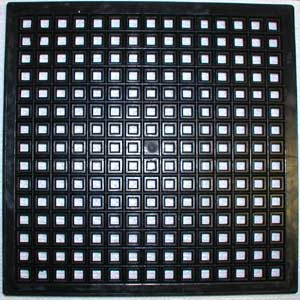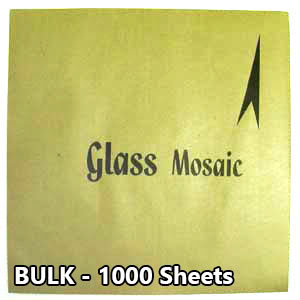
Mounting Grid for 3/4-Inch (20mm) Glass Mosaic Tiles is for temporarily mounting patterns of uncut tile to mounting paper for rapid installation using the indirect method. These are not needed for most projects. Most artists use cut tiles or glue each tile directly on the surface they are covering and do not need grids.
The grid mounts 225 glass mosaic tiles (3/4-inch size) on a 1.15 square foot piece of mosaic mounting paper in a uniform grid of 15 x 15 tiles with a standard grout gap of approximately 1/16 inch.
Note that sockets of the grid has bevels at the edges which match those on the bottom edges of glass mosaic tile, such as found on most varieties of 3/4-inch metallic glass and vitreous glass tile. In other words, the grid might not work as well for 3/4-inch tile which is completely flat on the bottom, such as might be found on stone tile or porcelain tile. With the flat-bottomed stuff, you might have to be a little more careful to keep the tiles from popping out as you apply the mounting paper.
Mosaic Tile Mounting Grid 3/4 Inch
- grid size: 15 tiles x 15 tiles.
- grid area: approximately 1.15 square foot.
- grout gap: approximately 1/16 inch.
- tile size: 3/4 inch (20mm).
The Indirect Method
Mosaic tile can be glued one at a time DIRECTLY to a surface, or you can lay your mosaic out on a temporary surface in what is called the “Indirect Method.” Temporary surfaces can include things like fiberglass mesh, paper, adhesive contact paper or trays filled with lime putty. Our grids were made to work with self-adhesive mounting tape or mounting paper that is glued to the faces of the tiles.
Why Use The Indirect Method
Why would you want to use the Indirect Method? It is easier to lay up your mosaic design at your work table than it is to lay it out on a floor or vertical wall. Also, you can work for days or weeks at your work table laying up the mosaic without tying up the location where the mosaic will actually be installed. Again, none of this is necessary for a beginner laying up a small craft project like a trivet or a mosaic mirror.
Use In Mosaic Art
The following is how to do the indirect method using our grids and mounting paper:
- Place glass mosaic tile into the grid face up, filling up the grid with your design.
- Dilute water-soluble glue such as Elmer’s Glue with 3 parts water to 1 part glue.
- Paint the water soluble glue onto the mounting paper using a small artists paint brush. Use a light coat to avoid wrinkling the paper.
- Lay mounting paper onto the face of the tile, careful to avoid wrinkles.
- Allow sheet to dry completely and remove from the grid.
- Spread thinset mortar or mosaic adhesive on the surface to be mosaiced.
- “Butter” the bottom of the sheet of tile with the same mortar or adhesive. Of coarse, you butter the bare glass bottoms of the tile, not the paper.
- Press the sheet of tiles into the adhesive-covered surface with the PAPER ON THE OUTSIDE.
- Allow the thinset or adhesive to cure for 24 hours.
- Mist the paper until it is soaked and peel it off the tiles.
- Grout the mosaic.
How To Make Mosaics
For more advice on designing your mosaic project or mounting, cutting, and grouting tile, please see our page of Mosaic Frequently Asked Questions or our Mosaic Information Guide, which lists instructional pages described by topic. We also post new articles about making mosaics at our How to Mosaic Blog.


